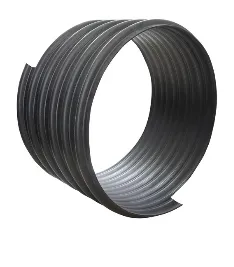Dec . 05, 2024 10:18 Bwererani ku mndandanda
How HDPE Pipes Improve Safety and Efficiency in Gas Distribution Networks
The demand for reliable, durable, and safe infrastructure for gas distribution networks has brought HDPE pipes into the spotlight. With their flexibility, resistance to environmental factors, and excellent performance under pressure, these pipes have revolutionized the gas industry. From HDPE double wall corrugated pipes to solid HDPE pipes, their applications extend beyond gas pipelines to drainage and water systems. This article explores how HDPE reinforced spiral corrugated pipes and other HDPE variations contribute to safer and more efficient gas distribution networks.

The Role of HDPE Double Wall Corrugated Pipe in Gas Distribution
HDPE double wall corrugated pipes are well-known for their lightweight yet sturdy construction. These pipes are engineered with a corrugated outer layer for structural support and a smooth inner wall that minimizes friction, enabling efficient gas flow. In gas distribution, where safety is paramount, these pipes excel due to their high impact resistance and flexibility.
Their ability to handle temperature fluctuations without cracking or deforming makes them ideal for outdoor applications where environmental conditions can be harsh. Additionally, the installation process is simplified due to their lightweight nature, reducing labor costs and improving efficiency.
Enhancing Safety with HDPE Reinforced Spiral Corrugated Pipe
For high-pressure gas systems, HDPE reinforced spiral corrugated pipes offer unmatched strength and reliability. The spiral design reinforces the pipe’s structural integrity, enabling it to withstand heavy loads and challenging conditions. This makes them particularly suited for underground gas distribution networks where stability and durability are crucial.
These pipes are often fused using advanced techniques such as electrofusion or butt fusion, creating seamless joints that eliminate potential leak points. Such secure connections are vital in gas networks to prevent leakage and ensure safe operation over extended periods.
Why HDPE Black Pipe Is a Preferred Choice in the Gas Industry
HDPE black pipes are frequently used in gas distribution due to their UV resistance and high flexibility. Their black color is not just for aesthetics; it provides additional protection against UV degradation, ensuring long-term performance even in exposed installations.
These pipes are resistant to corrosion and chemical attacks, which are common challenges in underground gas pipelines. Furthermore, their smooth internal surface reduces friction, allowing for consistent gas flow and minimizing energy loss during transportation.
Applications of Solid HDPE Pipe in Gas Networks
Solid HDPE pipes are prized for their ability to maintain structural integrity under high-pressure conditions. They are commonly used in both primary gas distribution and smaller-scale delivery systems. These pipes are constructed with a uniform material that provides consistent strength along their length.
Their solid structure also makes them impermeable to gas, ensuring no leakage even under fluctuating pressure levels. This feature, combined with their ease of installation, has led to widespread adoption in the gas industry.
HDPE Drainage Pipe: Versatility Beyond Drainage
While HDPE drainage pipes are primarily designed for water management, their properties make them suitable for specific applications in gas systems. Their lightweight nature and ease of handling make them a practical choice for temporary gas lines or auxiliary systems.
The corrugated design enhances their flexibility, allowing them to adapt to uneven terrains often encountered in gas distribution projects. Additionally, their resistance to abrasion and chemical reactions ensures longevity in diverse environments.
The safety and efficiency of gas distribution networks hinge on the reliability of the materials used. The integration of HDPE black pipes ndi HDPE drainage pipes further enhances the versatility of these systems, making them indispensable in modern infrastructure. By choosing HDPE pipes, industries not only secure a robust and long-lasting gas network but also benefit from reduced maintenance costs and improved environmental sustainability. These advantages make HDPE pipes the future of safe and efficient gas distribution.
-
Welding Rods: The Backbone of Plastic Welding Applications
NkhaniJun.06,2025
-
PVC Sheet: A Versatile Material for Modern Construction and Design
NkhaniJun.06,2025
-
PVC Rod: A Reliable and Versatile Material for Industrial Applications
NkhaniJun.06,2025
-
Pipe Fittings: Essential Components for Secure and Efficient Plumbing Systems
NkhaniJun.06,2025
-
HDPE Sheet: Durable, Versatile, and Eco-Friendly Plastic for All Applications
NkhaniJun.06,2025
-
HDPE Pipe Solutions: Durable, Versatile, and Built to Last
NkhaniJun.06,2025

